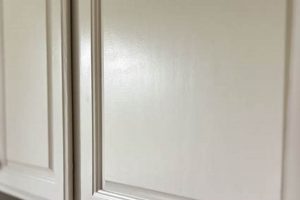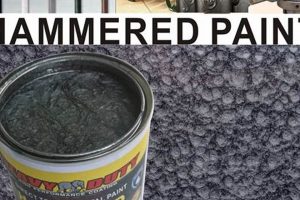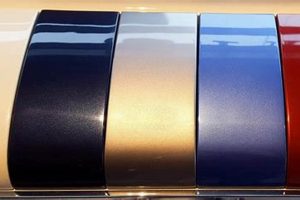The selection of the appropriate coating for interior wet environments represents a critical decision in building maintenance and design. This choice directly influences the longevity, aesthetics, and hygiene of the space. For example, coatings designed for such areas must resist moisture penetration and inhibit the growth of mold and mildew.
Employing suitable surface treatments in these environments provides multiple advantages. It ensures the prolonged structural integrity of the substrate material, reduces the frequency of maintenance interventions, and contributes to a healthier indoor environment. Historically, oil-based formulations were favored, but advancements have led to the development of more durable and environmentally responsible alternatives.
The subsequent discussion will delve into the specific attributes of various coating types and their suitability for use in moisture-prone interior areas. This includes an examination of sheen levels, application techniques, and considerations for long-term performance and ease of cleaning.
Essential Considerations for Coatings in Wet Interior Environments
Selecting an appropriate coating for a bathroom is crucial for longevity, aesthetics, and hygiene. The following points provide guidance on making informed decisions.
Tip 1: Prioritize Moisture Resistance: Opt for products specifically formulated to withstand high humidity and direct water exposure. Latex-based acrylic formulations and epoxy coatings offer superior protection against moisture penetration.
Tip 2: Select the Appropriate Sheen Level: Semi-gloss or gloss sheens are recommended due to their enhanced durability and ease of cleaning. Matte finishes, while aesthetically pleasing, are more susceptible to moisture damage and staining.
Tip 3: Prepare the Surface Meticulously: Thoroughly clean and prime surfaces before application. Remove any existing mold or mildew and repair any imperfections to ensure proper adhesion and prevent future problems.
Tip 4: Apply Multiple Thin Coats: Applying several thin coats is preferable to a single thick coat. This technique promotes even coverage, enhances durability, and minimizes the risk of blistering or peeling.
Tip 5: Ensure Adequate Ventilation: Maintain proper ventilation during and after application to facilitate drying and prevent the accumulation of harmful fumes.
Tip 6: Consider Antimicrobial Additives: Incorporate antimicrobial additives into the coating to inhibit the growth of mold, mildew, and bacteria, contributing to a healthier environment.
Tip 7: Regularly Inspect and Maintain: Periodically inspect coated surfaces for signs of damage or deterioration. Promptly address any issues to prevent further degradation and prolong the lifespan of the coating.
Tip 8: Choose Durable and Cleanable Options: Durability is key. Options offering easy clean-up are also desirable to prevent the buildup of stains and other undesired visual artifacts.
Following these recommendations will contribute to a durable, aesthetically pleasing, and hygienic bathroom environment, minimizing maintenance and extending the lifespan of the coated surfaces.
The next section will address specific product recommendations and case studies, further illustrating the principles discussed above.
1. Moisture Resistance
The selection of a surface coating for bathroom environments necessitates a primary focus on moisture resistance. The inherent conditions of high humidity and potential direct water exposure within bathrooms pose a significant threat to the integrity and longevity of coated surfaces. Absent adequate resistance, moisture penetration leads to a cascade of detrimental effects, including blistering, peeling, and the proliferation of mold and mildew. Consequently, the durability and aesthetic appeal of the coating are compromised, necessitating frequent and costly remedial actions. The link between moisture resistance and the overall efficacy of a coating in this environment is therefore direct and consequential; one dictates the success or failure of the other.
Consider, for example, a bathroom coated with a standard interior emulsion lacking specific water-resistant properties. After a relatively short period of exposure to regular shower steam and water splashes, the coating is likely to exhibit visible signs of degradation. Blisters may form beneath the surface as moisture becomes trapped, and peeling can occur along edges and seams. Moreover, the damp environment provides an ideal breeding ground for mold and mildew, which can not only damage the coating but also pose health risks to occupants. In contrast, a coating specifically formulated with enhanced moisture resistance will prevent water from penetrating the surface, thereby mitigating these risks and preserving the coating’s integrity over an extended period.
In summary, moisture resistance is not merely a desirable attribute of a bathroom coating; it is a fundamental requirement. Failing to prioritize this characteristic results in a compromised coating system, increased maintenance costs, and potential health hazards. Addressing moisture resistance proactively through the selection of appropriate coatings and proper application techniques is essential for ensuring the long-term performance and functionality of bathroom surfaces. Future research should focus on the development of even more durable and environmentally friendly water-resistant coating technologies.
2. Sheen Level
The selection of sheen level exerts a considerable influence on the aesthetic appearance, functionality, and maintenance demands of coatings applied in bathroom environments. This characteristic dictates the degree of light reflectance from the coated surface, affecting visual perception and influencing its resistance to moisture and ease of cleaning.
- Moisture Resistance and Durability
Higher sheen levels, such as semi-gloss and gloss, inherently offer enhanced moisture resistance due to their tighter molecular structure. This reduced porosity inhibits water penetration, mitigating the risk of blistering, peeling, and the growth of mold and mildew, which are common concerns in moisture-prone bathrooms. The increased durability associated with higher sheens also provides greater resistance to scrubbing and cleaning, essential for maintaining a hygienic environment.
- Cleanability and Maintenance
The smooth, non-porous surface characteristic of higher sheen coatings facilitates easier removal of stains, soap scum, and other bathroom contaminants. Lower sheen options, such as matte finishes, possess a more textured surface that can trap dirt and moisture, making them more difficult to clean and increasing the likelihood of staining. Consequently, higher sheen levels generally require less frequent and less intensive cleaning efforts.
- Aesthetic Considerations and Light Reflection
Sheen level directly impacts the perceived brightness and visual texture of the bathroom. Glossier finishes reflect more light, creating a brighter and more spacious feel, particularly beneficial in smaller bathrooms or those with limited natural light. Matte finishes absorb more light, resulting in a softer, more subdued appearance. However, matte coatings may also accentuate surface imperfections, requiring meticulous surface preparation prior to application.
- Application and Surface Imperfections
Higher sheen coatings tend to highlight surface imperfections more readily than lower sheen alternatives. Therefore, meticulous surface preparation is paramount when using gloss or semi-gloss finishes. Any irregularities, such as dents, scratches, or uneven patching, will be more noticeable. Conversely, matte finishes offer greater concealment of minor imperfections, simplifying the preparation process.
The interplay between sheen level and the environmental conditions of a bathroom dictates the long-term performance and aesthetic appeal of the coating. While higher sheen levels provide superior moisture resistance and cleanability, they also necessitate more rigorous surface preparation and may not be suitable for all design preferences. Therefore, a judicious evaluation of these factors is essential for achieving optimal results.
3. Surface Preparation
Surface preparation is a foundational determinant of the success and longevity of any coating system within a bathroom environment. The presence of moisture, temperature fluctuations, and potential for microbial growth necessitates a meticulous approach to surface preparation to ensure optimal adhesion and performance of the chosen coating.
- Cleaning and Decontamination
The initial step involves the complete removal of existing contaminants, including soap scum, mold, mildew, grease, and loose debris. Failure to adequately clean the surface inhibits proper adhesion and can lead to premature coating failure. Specific cleaning agents formulated for bathroom environments are often required, followed by thorough rinsing and drying. For surfaces exhibiting mold or mildew, specialized biocidal treatments are essential to prevent recurrence. Example: Residual soap scum acts as a bond breaker between the substrate and the coating, resulting in peeling and chipping.
- Repairing Imperfections
Existing cracks, holes, and uneven surfaces must be addressed prior to coating application. These imperfections not only detract from the aesthetic appearance but also create potential entry points for moisture. Appropriate patching compounds should be used to fill voids, followed by sanding to create a smooth, uniform surface. The type of patching compound should be compatible with the substrate material and the chosen coating. Example: Unfilled hairline cracks allow moisture ingress, promoting subsurface corrosion or wood rot beneath the coating.
- Priming
The application of a primer serves multiple functions, including sealing porous surfaces, improving adhesion, and providing a uniform substrate for the coating. The selection of an appropriate primer is critical, with consideration given to the substrate material, the type of coating being applied, and the specific environmental conditions. Primers formulated for moisture-prone environments often incorporate mildewcides. Example: Applying a latex coating over a glossy oil-based surface without priming results in poor adhesion and eventual peeling.
- Sanding and Surface Profiling
Sanding creates a mechanical key for the coating to adhere to, particularly on smooth or glossy surfaces. The appropriate grit sandpaper should be selected based on the substrate material and the desired surface profile. Excessive sanding can damage the surface, while insufficient sanding results in inadequate adhesion. Dust generated during sanding must be thoroughly removed prior to coating application. Example: Failing to sand a pre-existing semi-gloss coating results in a smooth, non-porous surface, hindering mechanical adhesion of the subsequent coat.
In conclusion, surface preparation represents an indispensable prerequisite for achieving a durable, aesthetically pleasing, and moisture-resistant coating within bathroom environments. Each facet of the preparation process, from cleaning and repair to priming and sanding, contributes to the overall performance of the coating system. Neglecting these steps compromises the integrity of the coating, leading to premature failure and increased maintenance costs. A comprehensive and meticulous approach to surface preparation is, therefore, paramount for ensuring the long-term success of any bathroom coating project.
4. Application Technique
The correlation between application technique and the final appearance and durability of a surface coating within a bathroom is substantial. A meticulously selected coating can perform suboptimally, or even fail prematurely, if improperly applied. Variability in humidity and temperature found in bathrooms amplifies the significance of proper application. Consequently, the methodology employed during application directly influences resistance to moisture ingress, adhesion to the substrate, and the overall aesthetic uniformity of the completed surface.
Consider two scenarios. In one, a high-quality, moisture-resistant coating is applied in a single, thick layer using an inappropriate brush type. The resulting surface exhibits brush strokes, uneven drying, and potential for sagging. The excessive coating thickness hinders proper curing, leading to trapped moisture and a weakened bond with the substrate. Conversely, the same coating, applied in multiple thin layers using a high-quality roller, yields a smooth, uniform surface with enhanced adhesion and resistance to moisture penetration. The increased surface area exposure during the application of thin coats facilitates thorough curing, contributing to a more durable and aesthetically pleasing outcome. Another factor that is sometimes disregarded is the importance of back-rolling to ensure adequate film build over surface profile.
In summary, application technique represents a critical component in achieving the desired outcome for surfaces in bathroom environments. The employment of appropriate tools, the application of multiple thin coats, and adherence to recommended curing times are essential for maximizing coating performance. Inadequate application undermines the inherent qualities of even the most advanced coatings, resulting in diminished aesthetics, reduced durability, and increased susceptibility to moisture-related damage. A thorough understanding of and adherence to best practices in application technique are, therefore, indispensable for ensuring the long-term success of a bathroom surface coating project.
5. Ventilation
Adequate ventilation plays a critical, often overlooked, role in the long-term performance of coating systems in bathrooms. The high humidity levels characteristic of these environments create conditions that can severely compromise surface coating integrity. Without proper air circulation, moisture becomes trapped, extending drying times and increasing the likelihood of various failure mechanisms.
The primary consequence of inadequate ventilation is prolonged exposure to elevated moisture levels. This prolonged exposure facilitates the penetration of moisture into the coating, weakening its bond with the substrate. Over time, this can lead to blistering, peeling, and cracking of the coating. Furthermore, trapped moisture fosters the growth of mold and mildew, organisms that not only degrade the coating but also pose potential health hazards to occupants. Consider a bathroom with a newly applied coating where ventilation is absent; the persistent condensation on surfaces significantly increases the risk of these problems developing within a short timeframe. Conversely, a bathroom with a functional exhaust fan and open windows will experience faster drying times and reduced moisture buildup, thereby extending the lifespan of the coating.
Effective ventilation strategies, including the installation of adequately sized exhaust fans and the encouragement of natural airflow through open windows, are essential for maintaining the integrity of surface coatings in bathrooms. Addressing ventilation deficiencies proactively can significantly reduce the frequency of maintenance, prevent costly repairs, and promote a healthier indoor environment. Failure to recognize and address the importance of ventilation undermines the benefits of even the most advanced coating systems. It follows, that a holistic approach, incorporating both appropriate surface coatings and effective ventilation strategies, is essential for optimal long-term performance.
6. Antimicrobial properties
The incorporation of antimicrobial properties into coatings intended for bathrooms is a proactive measure designed to mitigate the growth of microorganisms on coated surfaces. This is particularly relevant in bathrooms due to the persistent presence of moisture and humidity, conditions conducive to the proliferation of bacteria, mold, and mildew.
- Inhibition of Microbial Growth
The primary function of antimicrobial additives is to inhibit the growth and propagation of microorganisms on the surface of the coating. These additives disrupt cellular processes essential for microbial survival, effectively preventing colonization and biofilm formation. This is crucial in bathrooms, where surfaces are frequently exposed to water and organic matter, creating a favorable environment for microbial proliferation. Example: Coatings with zinc pyrithione or silver ions disrupt microbial cell walls, preventing their reproduction.
- Reduction of Odors and Staining
Microbial growth on coatings can lead to unpleasant odors and unsightly staining. Antimicrobial additives can reduce or eliminate these issues by preventing the microorganisms responsible for producing these effects from thriving. This contributes to a more hygienic and aesthetically pleasing bathroom environment. Example: Certain bacteria produce volatile organic compounds (VOCs) that cause musty odors; antimicrobial agents suppress this bacterial activity.
- Prolonged Coating Lifespan
Microbial activity can degrade coatings over time, leading to discoloration, cracking, and peeling. By inhibiting microbial growth, antimicrobial additives can extend the lifespan of the coating and reduce the frequency of maintenance and recoating. Example: Mold growth penetrates the coating and weakens its structure, causing blistering and peeling; antimicrobial agents prevent this degradation.
- Enhancement of Hygiene and Health
The presence of microorganisms in bathrooms can pose health risks, particularly for individuals with compromised immune systems. Antimicrobial coatings can reduce the levels of harmful microorganisms on surfaces, contributing to a healthier indoor environment. Example: Certain bacteria can cause skin infections or respiratory problems; antimicrobial surfaces reduce exposure to these pathogens.
The strategic incorporation of antimicrobial properties into coatings designed for bathrooms provides multifaceted benefits, ranging from inhibiting microbial growth and reducing odors to prolonging the coating’s lifespan and enhancing overall hygiene. The selection of antimicrobial coatings represents a practical approach to mitigating microbial-related issues and improving the quality of the bathroom environment.
Frequently Asked Questions
This section addresses common inquiries and misconceptions regarding surface coatings in bathrooms, providing objective and informative answers.
Question 1: What differentiates coatings formulated for bathrooms from standard interior coatings?
Bathroom coatings are engineered with enhanced moisture resistance, often incorporating antimicrobial additives to inhibit mold and mildew growth. Standard interior coatings lack these specialized properties, rendering them susceptible to degradation in high-humidity environments.
Question 2: Are specific sheen levels more appropriate for bathrooms?
Higher sheen levels, such as semi-gloss or gloss, are generally recommended. These finishes offer superior moisture resistance and ease of cleaning compared to matte finishes, which are more porous and prone to staining.
Question 3: How crucial is surface preparation prior to applying a bathroom coating?
Surface preparation is paramount. Thorough cleaning, repair of imperfections, and priming are essential to ensure proper adhesion and prevent premature coating failure. Neglecting these steps compromises the long-term performance of the coating.
Question 4: Does the application technique impact the coating’s effectiveness?
Yes, the application technique significantly influences the final result. Multiple thin coats applied with appropriate tools are preferred over a single thick coat, promoting even coverage, enhanced adhesion, and optimal curing.
Question 5: Why is ventilation important during and after coating application?
Adequate ventilation facilitates drying, prevents the accumulation of harmful fumes, and reduces moisture buildup, thereby minimizing the risk of blistering, peeling, and mold growth.
Question 6: Do antimicrobial additives guarantee complete protection against mold and mildew?
Antimicrobial additives significantly inhibit microbial growth but do not provide absolute protection. Regular cleaning and maintenance remain essential for preventing the proliferation of mold and mildew.
Proper coating selection, meticulous preparation, appropriate application, and diligent maintenance are all critical components for achieving long-lasting and aesthetically pleasing results. Addressing all aspects is imperative.
The subsequent section will delve into real-world case studies to further illustrate optimal coating practices for bathroom environments.
Considerations for “Paint Finish in Bathroom” Applications
The preceding discussion has delineated the critical factors influencing the selection, application, and maintenance of surface coatings in bathroom environments. These considerations encompass moisture resistance, sheen level, surface preparation, application technique, ventilation, and the incorporation of antimicrobial properties. A comprehensive understanding of these elements is essential for ensuring the longevity, aesthetic appeal, and hygiene of coated surfaces within these inherently challenging spaces.
Prioritizing informed decision-making and adherence to best practices is paramount for achieving optimal results and mitigating potential risks. Therefore, diligent evaluation and implementation of the outlined principles represents a sound investment, promoting a durable, healthy, and visually pleasing environment for years to come.







